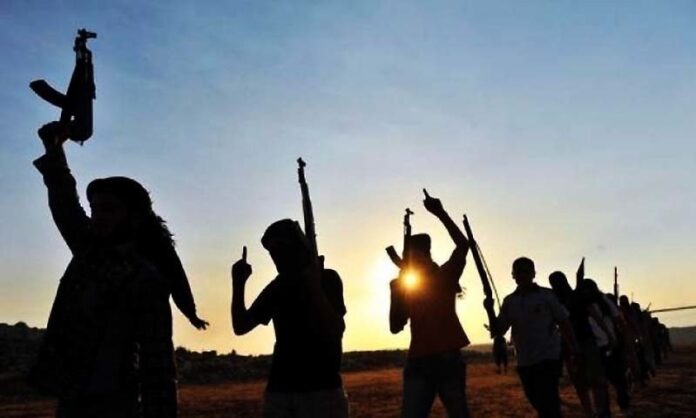
“Yes, anti-Pakistan terror outfits are in Balochistan via Sistan,” was the reply in response to a question by Dr Shazia Sobia Aslam Soomro, a PPP MNA. It also confirmed that regrouping of various terror groups was responsible for the recent wave of violence in Balochistan.
The ministry also informed the house that the National Intelligence Coordination Committee (NICC) had been institutionalized to integrate all federal and provincial intelligence grids for effective and timely countermeasures.“Persistent intelligence-based operations are being undertaken to neutralise terror organisations,” the response stated, adding that operational capabilities of the counterterrorism apparatus were being enhanced.
Most of violence – at least seven major attacks – since early this year have been claimed by the Baloch Nationalist Army (BNA), the Tehreek-i-Taliban Pakistan (TTP) and the self-styled Islamic State (IS) group. These also included the “fidayeen style” simultaneous raids on the camps of Frontier Corps in Nushki and Panjgur on Feb 2, 2022 at the same time. Officials claimed to have killed all 20 attackers. As many as nine security personnel, including an officer, also lost their lives in these surprise attacks.
We can look at these developments and the worsening of the security situation in Balochistan from three perspectives:
a) birth of yet another terror/militant franchise in the form of BNA
b) Continued splintering in the Baloch resistance ranks
c) Pakistan’s finger-pointing at the Iranian link (Sistan-Balochistan) in the Baloch militancy
d) China’s worry over the Iranian link in Balochistan’s insurgency
Baloch Nationalist Army (BNA) Enters the Fray?
Until late last year, the Baloch Liberation Army (BLA), Baloch Liberation Army (BRA) and the Baloch Liberation Front (BLF) had largely been carrying out attacks against security forces, mostly under the flagship of BRAS (Baloch Raaji Ajoi sangar) and the Baloch Republican Guards. Both emerged on the scene in 2019.
In 2020 Sindho Desh Republican Army (SRA) also joined the BRAS.
The dynamics of Baloch “resistance” changed in January this year when the Baloch Liberation Army BLA), Baloch Republican Army (BRA) and the United Baloch Army (UBA) , merged into Baloch Nationalist Army (BNA). The stated objective of the BNA is to “continue the war of resistance till independence of Balochistan.”
Nothing new indeed. Their announcement and the charter essentially resonates more or less the same ideals and objectives that other factions have held out as their mission for the rights of the Baloch people. On the face of it, the creation of BNA was meant to reinforce the “resistance” and hit state as hard as possible.
Interestingly, the birth of BNA also reflects another bitter reality of Balochistan’s militancy i.e. factionalisation of the resistance. In October 2021, the Baloch Republican Army had split into two factions when a BRA spokesman, Sarbaz Baloch, informed the media of separate operations – led from a new command and control hierarchy under Gulzar Imam, a BRA veteran from the Panjgur district. Internal rifts obviously led to this division, according to analysts familiar with Baloch resistance politics.
The attacks in Panjgur, Nushki looked like very much in synch with the BNA’s mission statement. In fact, the new outfit became known when it claimed responsibility for a terror attack on the Habib Bank in Lahore in February.
Some pro-independent Baloch leaders – even Brahmadagh Bugti and Mehran Marree – criticized the move saying attack on civilians outside Balochistan would damage the cause of the Baloch independence movement.
But Gulzar Imam, the chief of BNA, justified the strike saying that Habib Bank and its officials are part of the economy of the state and that the group would continue attacking the economic interests of the state of Pakistan even outside Balochistan.
“Although we don’t have the right to attack targets in Punjab but there is no voice in our support when operations are launched against Baloch people, “ Gulzar Imam told media via satellite phone.
The vow to hit Pakistan’s economic interests indeed betrayed the Proxy nature of the BNA. This also underscored that this outfit was yet another terror franchise to stoke violence and instability in Balochistan.
And here, let us revisit the ministry of interior statement to the National Assembly; “Yes, anti-Pakistan terror outfits are in Balochistan via Sistan.”
Isn’t it the first time Pakistan has officially brought the Iranian Sistan-Balochistan into the insurgency discourse?
Probably yes; does this imply Pakistan is complaining that Iran may be looking the other way, if not sheltering, anti-Pakistan insurgent groups using the Iranian territory for training and shelter?
And related to this is the Chinese worry; Beijing and Tehran are locked in a 25-year multi-billion dollar cooperation deal. That is why the latest information Baloch militant groups may be using the Iranian soil for instability and subversion in Pakistan’s Balochistan , must be worrying for China. How can Beijing continue investing in Iran, which may be ignoring the threats that militants based on its soil pose to China-led development projects in Balochistan?
Is there a geo-political dimension to the entire issue i.e. emergence of new terror franchises and an uptick in violence in Pakistan’s largest province which China wants to use for relocating its industrial output capacity for exports via the Arabian Sea?




